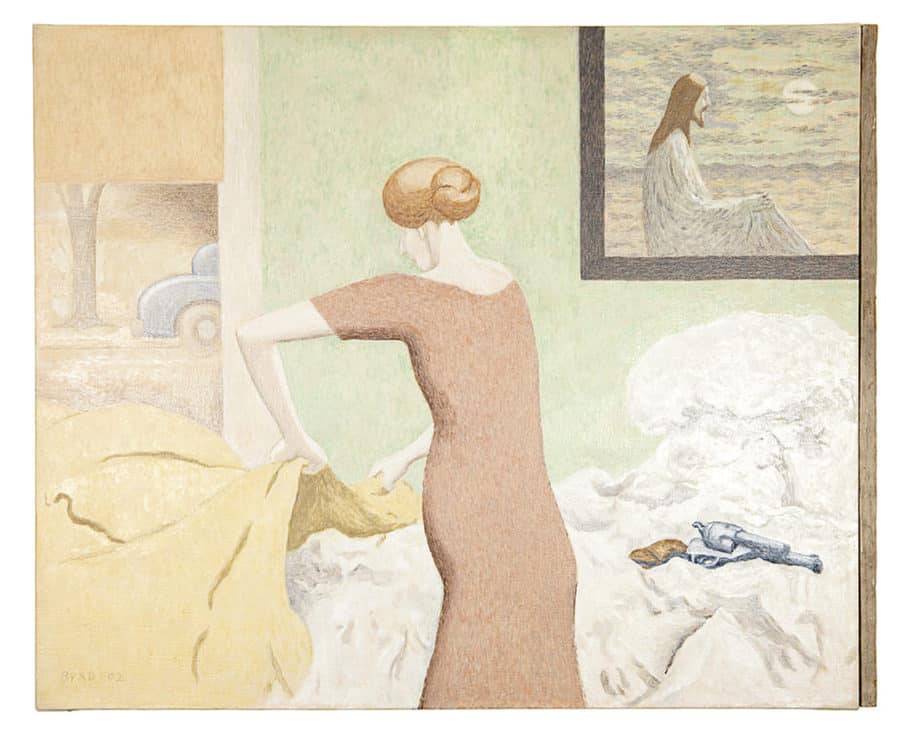Welcome back to our later summer/fall edition of Artists We Know. For our second series of articles for Quiet Lunch will be serving both new and lesser known artists as well as artists well into their respective careers. So without further ado: Our first article of this season profiles David Byrd, an artist since deceased whose oeuvre leaves an impression. We also interview Paul D’Agostino on executing the curation of DAVID BYRD: FLICKS, BOUTS, BLOCKS at STUDIO 10 (Brooklyn, NY) (David’s work is being supported by a 10 stop tour throughout NYS, that the author participated in. You should too!)
It’s about three and a half hours with the occasional 10-minute break to Sidney Center, NY, where David Byrd’s built his studio and colorful estate.
Upon the roads through town, past mountain and lush pastures, a feeling of lightness and the static of the radio. Miles turn to hours, the city, long past palpable.
But, who is David Byrd?
David Byrd (b. 1926 – 2013) was an eclectic visual artist of many trades, primarily working in painting, sculpture, and drawing. He pursued the written form as well, documenting his time while working at the VA, his teenage years in Brooklyn, serving his country, and traveling abroad.
He was born in a small town in Illinois to a father who suffered from mental illness. Not too long after his father’s disappearance, Byrd ended up in foster care which more than likely had a profound effect on him. Although his mother was able to return to the family unit, she was predominantly absent due to providing for David and his five siblings.
As an adult, Byrd was employed by the Montrose New York Veterans Association where he worked as a night orderly for thirty years.
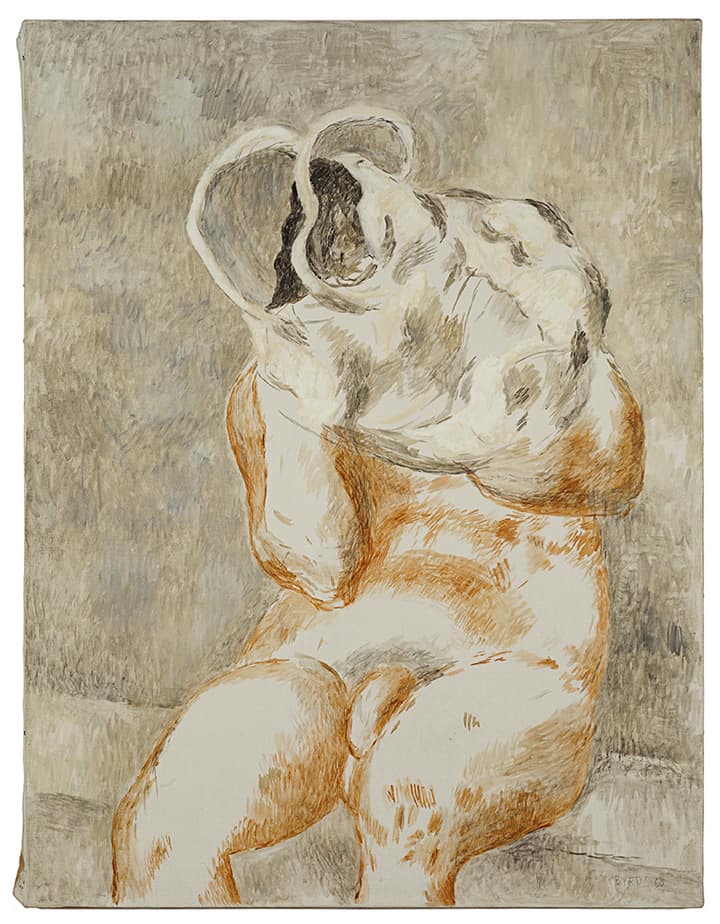
Putting on Top, oil on canvas, 1960, 34×26. Courtesy Of the David Byrd Estate
It was the lack of stability that might have filled the lifelong pursuit for a home — a nest which would encapsulate David’s world — completely of Byrd’s making. Home is a place you can try, fail, laugh at the mirror, pile a room with glass bottles and no one will judge you. It is often the only place often that we can be naive enough to grow and learn in without fear and with ever-present room for improvement. This space feeds and nourishes the mind. And a home, or the home that you make for yourself, is the best entry point to the soul. It’s all but a lone footnote that clings and quivers like a faint apparition throughout David Byrd’s life work.
Byrd’s life story is filled with so much movement that it would be a great undertaking for us to state all the strife and conundrums that life often brings with it. However, we will talk about several periods of Byrd’s life within the context of his works.
Although Byrd did attend art school, he largely stayed away from the hobnobbing and social snobbery that most artists of his time period partook in. As a social outsider, what happens to be the most striking and really the signature to many of his paintings, sculptures, and drawings is the obsession and observation of movement and the peculiar quirks of human behavior.
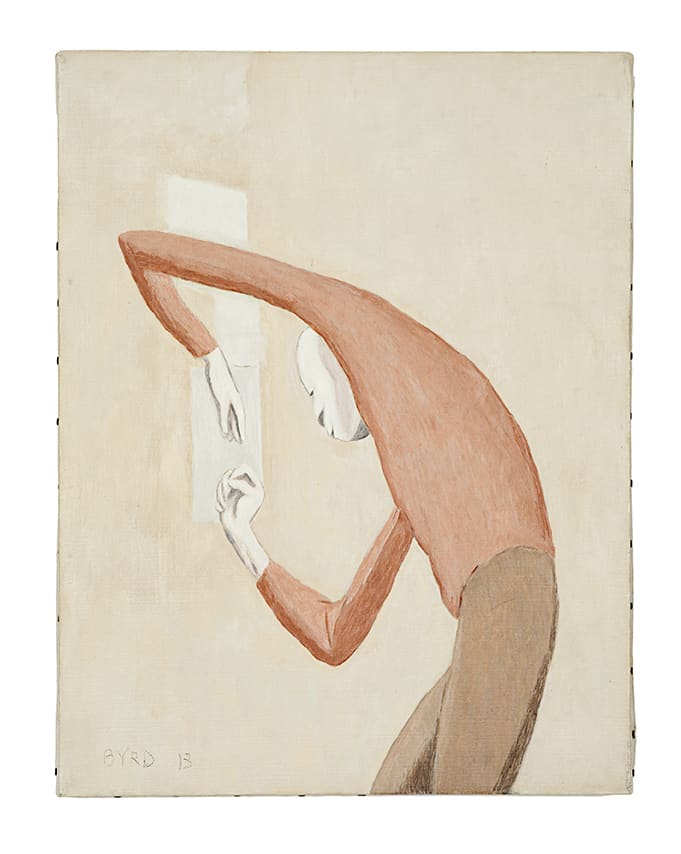
Man Signing, oil on canvas, 2013, 17×13. Courtesy of the David Byrd Estate.
As I pull the truck down a narrow one-way road, I pass the base of several foothills. David clearly had the intention of tranquil space. Within his open house one can wander and hear the breeze pick up in the fields. The scenery alone is almost reminiscent of early Hudson Valley painters, and being July is in the height of summertime.
In the house he built art is a moving form inhabiting each room with attention to placing. Much of the house itself was constructed in a contemporary northern European fashion with open floor plans, tall ceilings, and angular roofs. Even in much of his painting, Byrd occupies negative space with jutting edges that may impose itself on the figure, setting, or shape. Backgrounds and color fields are soft and matte with a technique that appears to repeat linear brush strokes within a shape to block color. This creates an effect much like digital noise in a photo, or static on an old T.V.
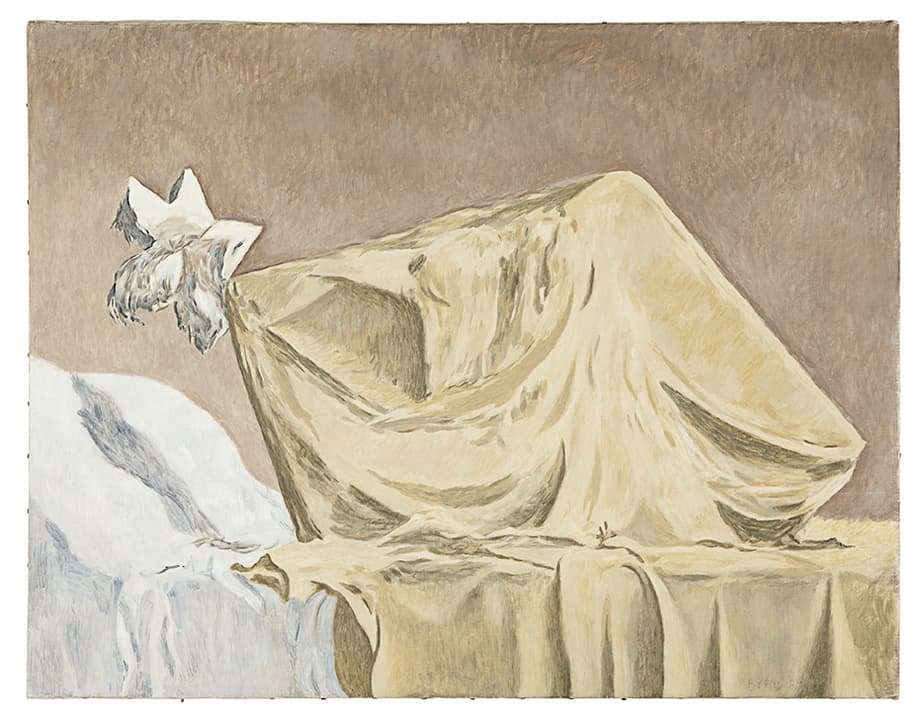
Awoken Patient, 1984, oil on canvas, 24×31. Courtesy of the David Byrd Estate
Walking throughout his house one imagines where exactly most structures derive their purpose. Certain themes in his home mimic those in his paintings and drawings. The sense of isolation, repression, judgment, sacrifice, the mundane, and depleted emotion repeat themselves, but possibly lived short due to the sheer amount of various stages his home and work appears in, and the unexpected time of his departure. Assuming the length of David’s career, it is remarkable for an artist to take such care with keeping track of their work without collectors, patrons, or gallery representation footing the bill for accelerated creative movement or the general expenses life creates.
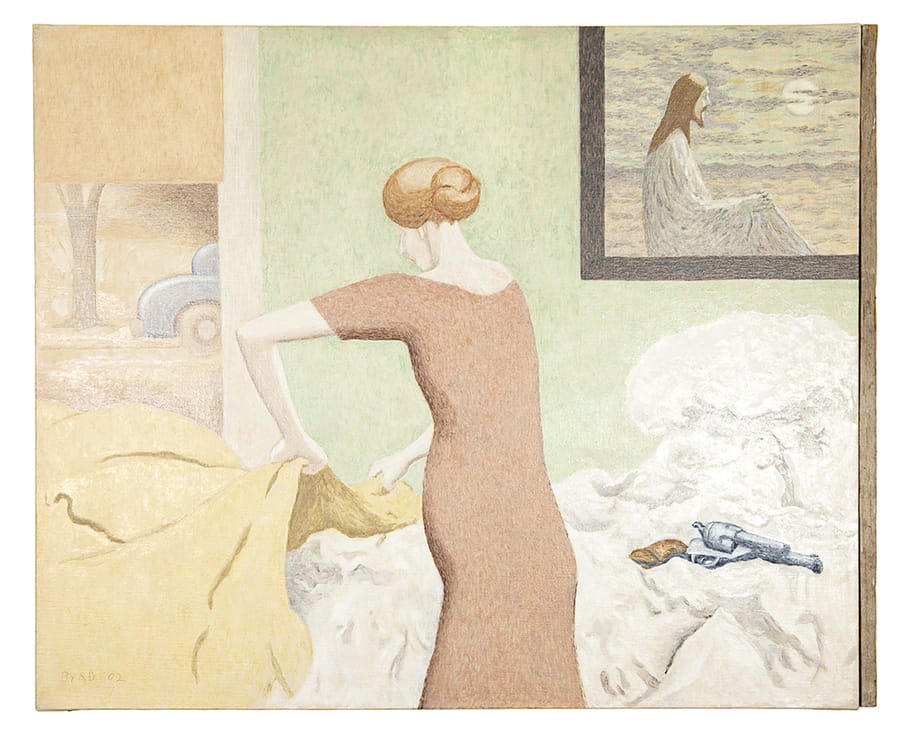
Making Bed in Coal Country, 2002, oil on canvas, 20×24. Courtesy of the David Byrd Estate
Hours later we are driving back to the city with a fondness. Our eyes heavy from the day, lazing on the road, determined. In many of David’s paintings figures jut out in surprising manners and form, especially within works he created during his time working as an orderly for the Monstrose Veteran’s Hospital. Most people, even ones who have been affected by mental illness, might not preoccupy their thought with the idea that people, no matter how affected or disaffected they are, have unique properties that are more than mere physical characteristics or mental faculties. From our understanding and observation, his time with these patients provided ample hours for studies, giving him the tools to understand more of his own behaviors, the behavior of others, and perhaps a clue to the nature of his father’s disappearance.
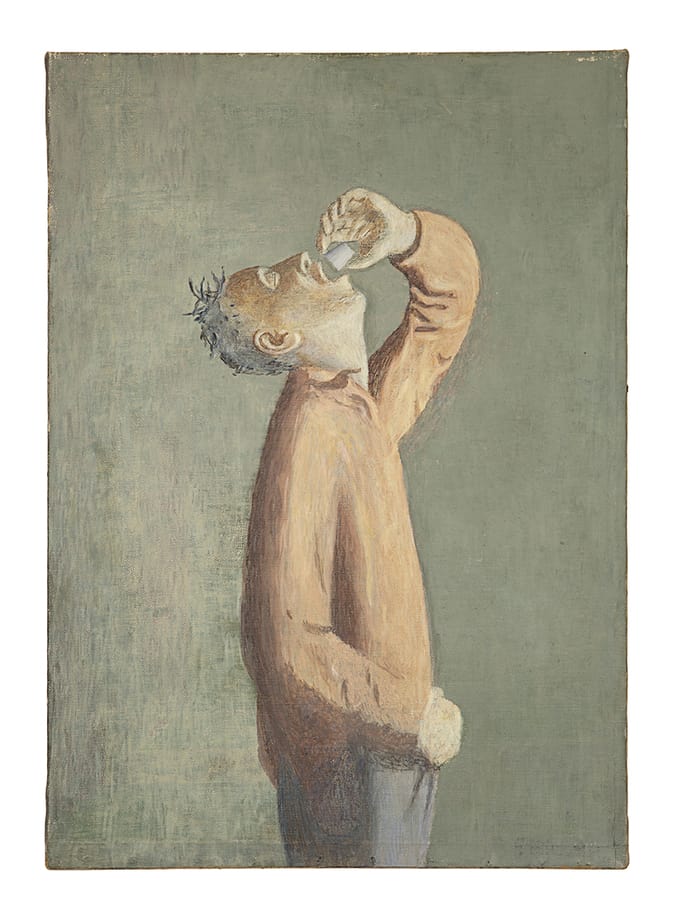
Patient Alone, oil on canvas, 1990, 20×14. Courtesy of the David Byrd EstateCourtesy of the David Byrd Estate
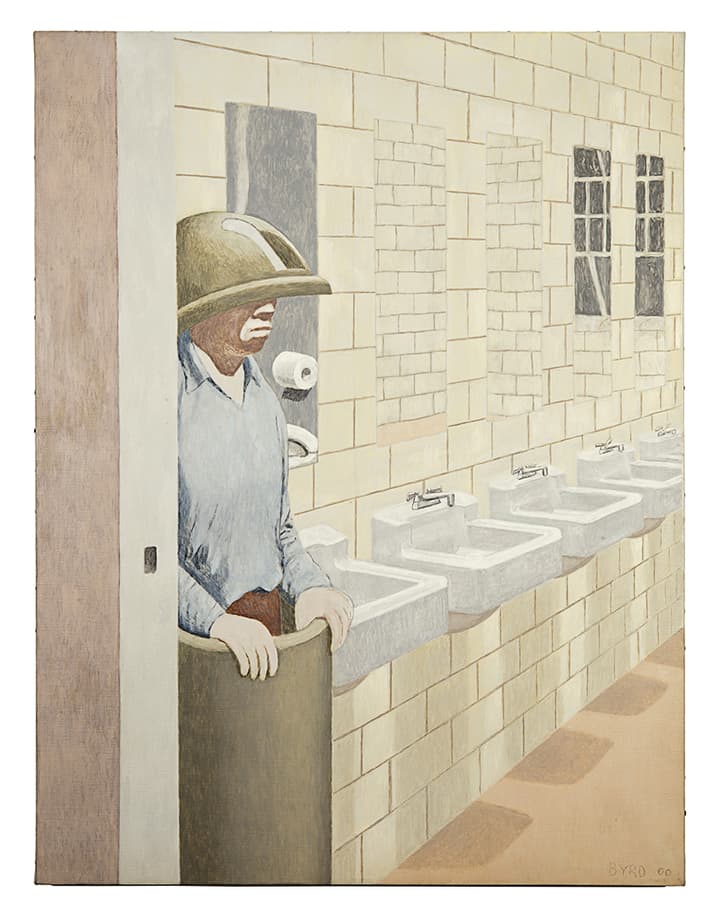
Man in Garbage Can, 2000, oil on canvas, 34 x 26 in. Courtesy of the David Byrd Estate
It is within these paintings, drawings, found objects, sculpture, house, and home, that we see where David possibly saw himself and his career all along…as just another piece or fragment to participate within a lifetime of creation.
After all, we all have our own fantasies, dreams, and delusions to thank us for humanities fortune and folly. Maybe the worlds we observe, create and participate in are vital, no matter the hardship or the endurance.
DAVID BYRD/BROOKLYN/NEW MONEY WITH PAUL:
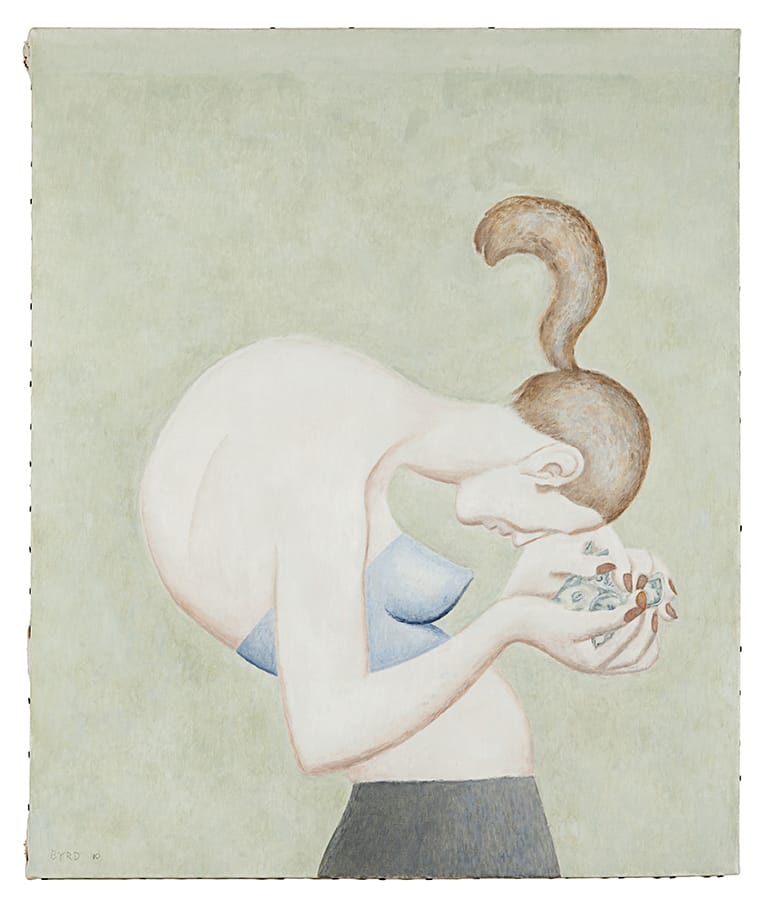
“Counting Money” oil on canvas, 2010, 30×25. Courtesy of the David Byrd Estate
J+A: Hi Paul, thank you for sitting down with us can you give us the backstory on how you began working with the David Byrd Estate and selecting some of his early works for your recent show you curated “Flicks, Bouts, Blocks”?
PD: I got involved initially because of a conversation. It’s pretty rare to find such an artist as prolific as David Byrd who also only happened to have his first solo show right after his death at 80. So, I wanted to know more and as heard more of his life story. That’s when I became quite enamored. Which led me further down the rabbit hole. David had a lifetime of work quite literally. Some of which dated back to the late 40’s when he was a teenager. I knew I wanted to be a part of this ongoing story and there were already many other shows happening within the time frame.
J+A: Does this show differentiate from other shows you’ve curated?
PD: The show differentiates from other shows primarily because I’ve never curated something directly from an estate before. So in that sense, I’ve never worked as a curator with an artist who had a complete absence of presence. That became major difference while working on this project.
J+A: You selected certain drawings and a few paintings for “Flicks, Bouts, Blocks” given that the artist is completely removed, how did this play out?
PD: Well, for this show I made a decision along with the estate of David Byrd that this was going to to be centralized around the earlier works. Now, coincidentally this work deals with many timeless colloquialisms that in-turn helped shape the curation. The depth we can get to a little later. In sum, I felt there were too many reoccurring themes within the archives and the more I understood this, the narrative of the show hit me, I thought ” Okay, this is where the heart of his work blooms.” But in a way, I did have a little bit more freedom in how I choose things.
J+A: That’s quite an undertaking, It seems to be the trend for curators to use the work as pedestals for their own interpretation. Which we think is great, but not too many curators really wish to explore the deeper aspect of an artist’s trajectory. With that said how did you actually get started?
PD: As a curator and an artist I really enjoy telling stories. I also like adding narrative elements even to my own work as an artist. So when I can add the narrative as a curator then that can be particularly fun.
Even though the direct message of David’s early work seemed obvious, there were these clues, little pieces here and there that really began to open up my own dialogue. When that happens it’s refreshing. Not only just to open up the conversation, but to further it with critical and cryptographic thinking.
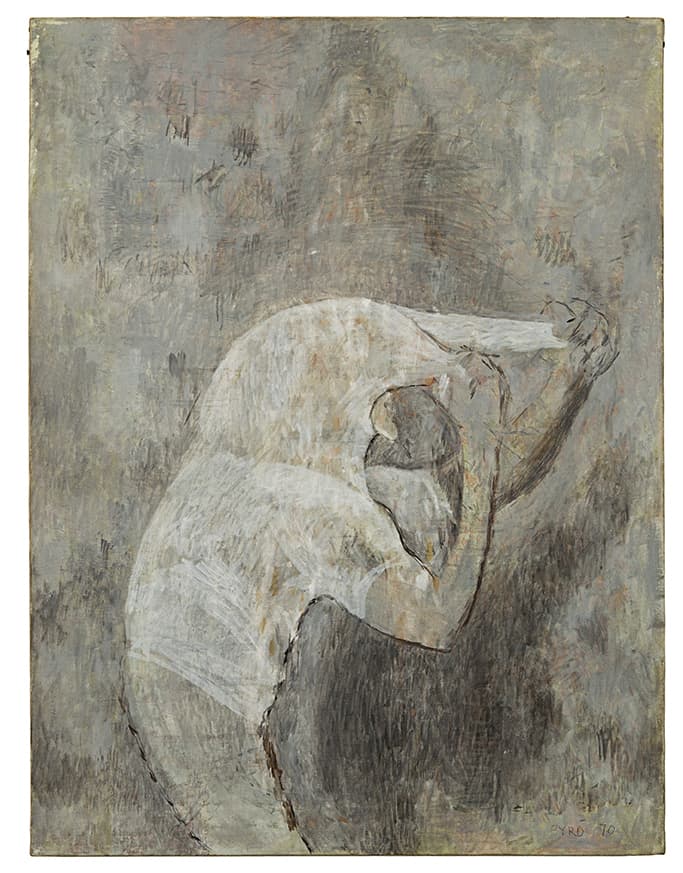
Pulling, oil on canvas, 1970, 29×22. Courtesy of the David Byrd Estate
J+A: Sometimes obvious meanings can have this underlining message that perhaps is un-intended for current viewers and therefore extends itself through time or perhaps sub consciously inspires the viewer to rethink their perceptions of the artist’s true intention. For example within our own paintings. The subject matter is difficult to approach and numinous in many ways. Subject matter i.e- (mental or psychological problems) can often require telling a complex story whilst entertaining the visceral and visual impulses that are as clear as nature itself.
PD: Definitely. I think it’s good to work with all the messages and underlying resources you have. If you’re only looking directly at the work and not questioning the obvious story which is sometimes a reoccurring (ha,ha) story. Then I think there wouldn’t be much room for debate amongst critics, collectors, or curators. Perspective or deviation of original intentions can lead to other theories… So, Within David’s work, there was plenty. But throughout the curation, my intention and implication were to lead the viewer into thinking about art within the larger context of his life and beyond, early and later. With regards to just my part with the curation of ” Flicks, Bouts, Blocks”. I am happy to have contributed to the “10 stops tour” and that ultimately it ties together with the other shows they’re (JI/JF, The David Byrd Estate, and trust) doing.
J +A: Yeah, It’s pretty incredible that any artist let alone one who was an outsider most of his life and could have 10 shows in three months! With that being said, Paul, how did the name ” Flicks, Bouts, Blocks” come to you?
PD: Well it was fortunate imitation, in the way that this was going to be the Brooklyn show so all of his (DB) works were going to be from his period in Brooklyn. And that obviously provides itself a more limited selection of his drawings and paintings. It also gave the show in an automatic context.
Most of his drawings and paintings from the Brooklyn era (1940-late 50’s) depict subject matter with boldly masculine scenes that don’t necessarily turn up again until later in his work. His composition does change over the decades although the one thing that stays pretty consistent in his work – from the earlier work or later works – is that from an early age to his 80’s he was working, so the talent was always there.
J+A: Paul, How did the name ” Flicks, Bouts, Blocks” come to you?
P+D: Among the initial ideas that I kind of immediately gravitated towards I eventually decided that there were to be three major points, quite literally within the curation and even within the order of viewing to this show. Since these works arrive from a period of time in Brooklyn when certain things were part and parlor, I wanted the work to follow along with the viewer. For short, the three actions that I reference in the title represent three different pinnacles of Brooklyn life as it was then and (ha, ha) pretty much still is today.“Flicks” is the first painting you see to left as you walk into studio 10. And it is a direct reference to the cinema and the days of matinees, double features, and something that I could imagine within the painting that he (DB) was directly referencing.
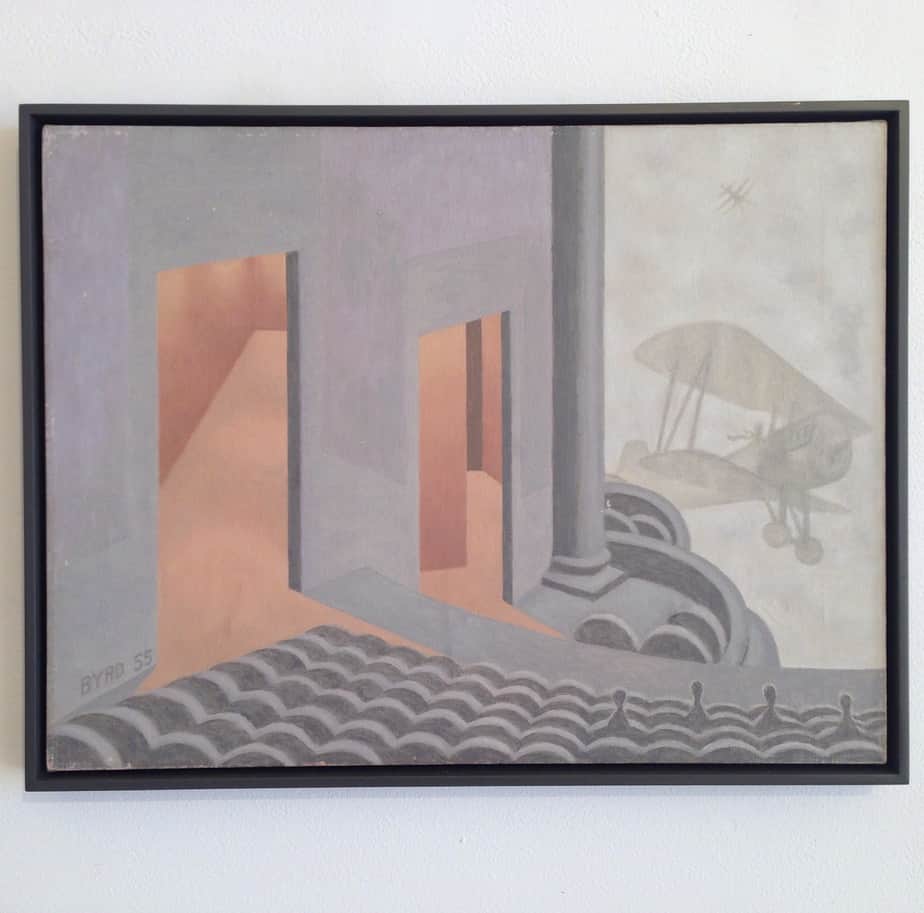
An installation View (AF) of Balcony With Screen, oil on canvas, 16″ x 21″, 1955. Courtesy of the David Byrd Estate & David Byrd: Flicks, Bouts, Blocks curated by Paul D’Agostino
(CONTINUED) “Bouts” can be the paintings pretty much parallel to the viewer as they walk into Studio 10.“Bouts” are the about half way through and references movement, being out on the town and possibly days where things were simpler/happier. Although“Bouts” could also be a direct connection to fights that he possibly would have seen on his apartment block or through the flicks at the cinema! Boxing matches, which appear throughout his drawings in the show, also add to the observation that the artist might have had inner battles of his own. As for “Blocks”. Blocks is a direct observation of the people.“Blocks” is painting of the storefront with the taxi to the painting of the couple on the bicycle.
(CONTINUED) “Blocks” are also the homeless stopping for change or the bar on the corner. So eloquently noted, David may have stayed away from social interaction but in-consequence became a patient observer of humanity in its humble form and so I said to myself I’ll try to understand what place this came from.
“Flicks, Bouts, Blocks” are all movements or contain movement and we can see many of these ideas from his early work turn up later in his work.
J+A: So Paul, just a couple more questions. We went to go check out David’s Estate and we can’t seem to avoid the stark contrast of his early work to
his later work. The frantic and often contained energy within many of his paintings, proclaim quite a contrast to the bucolic existence of isolation in-which he created. Do you see any of these contrasting dialogue in his work?
PD: I think you’re right on with that kind of duality — going out in the public and engaging and just looking really hard and coming back to mature and then seeing and doing something with it. I see that all of these different actions in his work. I mean I think he was already doing that even in his Brooklyn days when he was quite young. You know you go out into the public sphere, make some sketches, come back with lots of material and get inside the place where you can bottle them up, quite literally the duality is something that I can relate to with certain aspects of my own life.
J+A: He was definitely comfortable being solitary. Does it seem as if he possibly David could have been overwhelmed at times? Observation is a bit like watching television, but you are still there within a group of people.
PD: Hmm, possibly that was too much for him too and that maybe pushed him a little further away from society but he had a pretty rough life and he saw plenty of the world at a young age. I mean. For certain we know he ended up working with military veterans from the Korean War and World War II to Vietnam. And what he saw, you know I can’t imagine. I can’t imagine getting back to the states after an especially grueling war. So possibly this was his way of coping.
So on that note, we have a couple more questions about how you define your role as a curator in your community.
J+A: Paul, When presenting -or- curating an artist’s body of work does the neighborhood or community your showing in ever influence the way in which you present the body of work? For example, there is a certain expectation/standard for exhibitors in Chelsea. Are these sorts of standards or processes of engaging in the arts positive or negative in your experience?
PD: That’s a good question in the sense that a lot of people have asked many variations of that question (ha, ha)…Not precisely. In a certain way, I have been lucky to experience both sides of curating and I don’t particularly see a particular “trend” or “popular” theme when it comes to curating. At least I don’t see much continuity among smaller-medium size galleries. On the other hand, It has been very trendy for some time now to have a space in Bushwick, but I have been here and running http://centotto.com/ for over 10 years. So, I have seen both sides of the coin and the ethics do change as prices on spaces go up.
J+A: Bushwick certainly has variety. Do you see it as an ever-expanding thing? Or are we at sort of an apex? It seems to me when commercial spaces become too much of a commodity then there is usually a downward trend. Whats your take on this Paul?
PD: Of course with formalization, some things become out of reach for the smaller galleries and studios. For me being here for a long time it was at least a little bit cheaper to live out here up to 4-5 years ago. Now that’s not quite the case anymore. It is still the case that it’s a little bit cheaper to run a space that would be three to four times the price of the city out here and because of that a lot of them will invest their money in a bigger space and space can provide larger installations, taking chances on lesser known artists, just trying new things. But is that a finite resource that is being tapped dry? Who knows, I think that while they can they will.
PD: But for all these reasons I think it would be hard to find the same extent and range of the kinds of work we show. The age range of artists much broader and the number of spaces that are run by an artist or collective is still active. It’s definitely a weird mix up here at this point.
J+A: Lack of space can be definitely an issue, especially where we live in the LES.
With that said it’s been a pleasure getting to know some of the thoughts on David Byrd, curating, installation, and Bushwick in its finest hours. Before we go any hopes for the future?
PD: Hmm… I don’t know, maybe Bushwick will continue on its path or maybe the whole thing gets blown to bits. We’ll see whats up next! Thanks for having me!
Every two weeks for the next several months we will be publishing new and engaging articles emphasizing the importance of independence within our creative community. Stay tuned for more compelling stories by @jaredxalannah for ‘Artists We Know’ series: II & Quiet Lunch Magazine.
You can check out Paul D’Agostino, his bio & next show here: Centotto Gallery
For more info on David Byrd visit: The David Byrd Estate and Trust

Artist duo Jared Oppenheim and Alannah Farrell work in mediums that include painting, multi-media and installation works.
Their work has appeared in publications including Quiet Lunch, Juxtapoz, NY Magazine’s Bedford + Bowery, New York Optimist, Next, and The Wild Magazine, amongst others.
Together and separately their work has been presented and curated in London, Berlin, and in NYC. Currently, they live and work in the East Village, NYC.
For more of Jared x Alannah’s AWK Series, click here.

